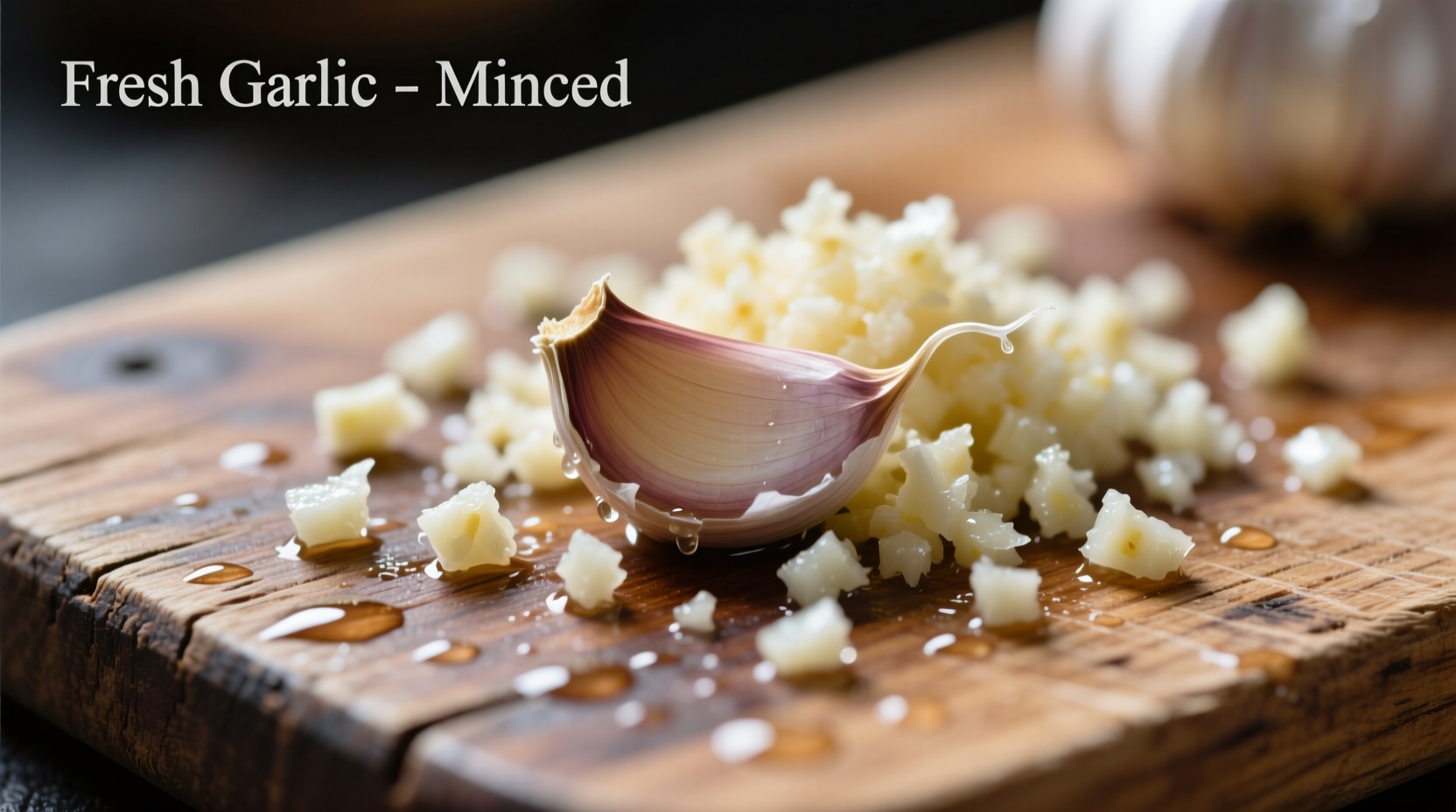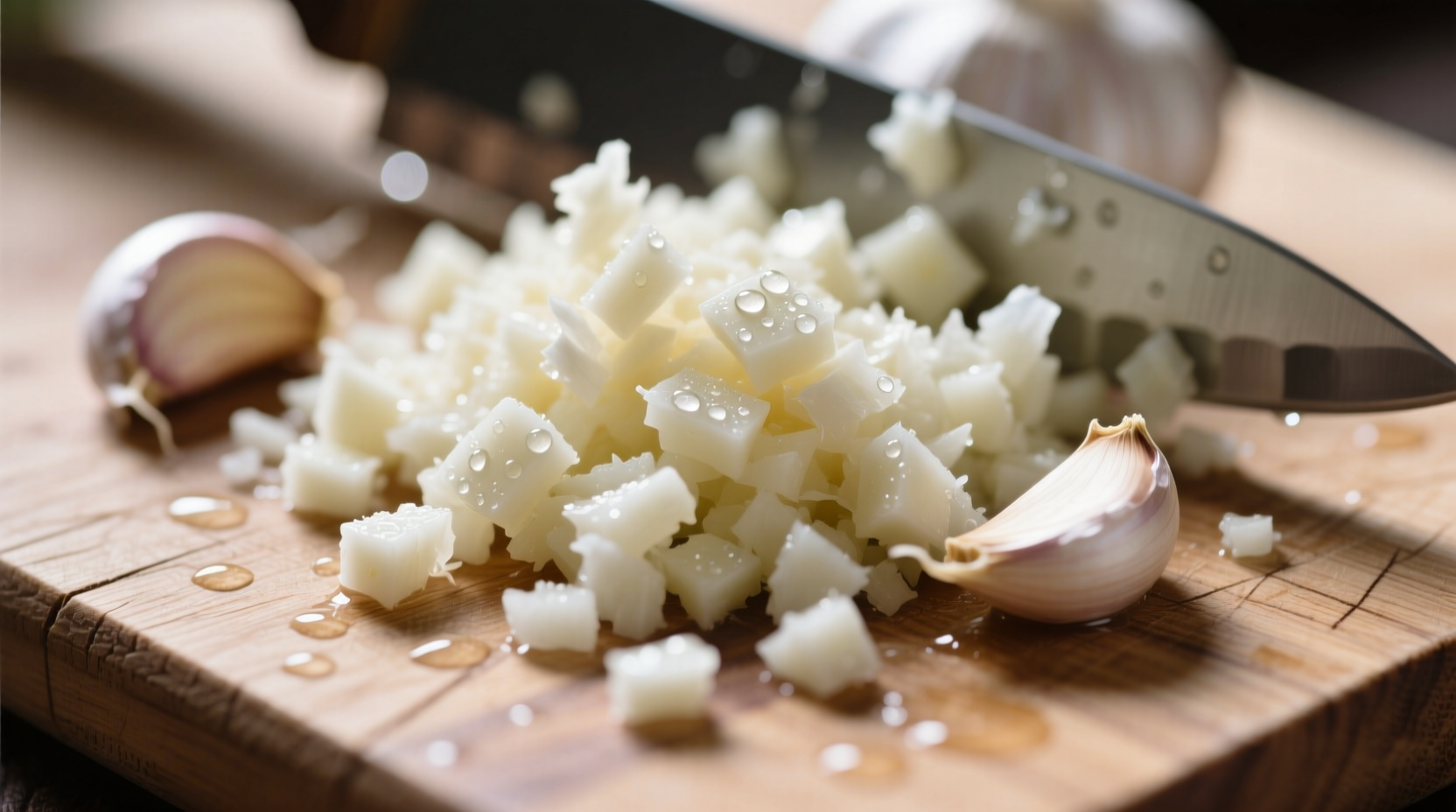The Flavor Science Behind Fresh Minced Garlic
When you cut or crush a garlic clove, you trigger a chemical reaction between alliin (a sulfur-containing amino acid) and the enzyme alliinase. This produces allicin, the compound responsible for garlic's pungent aroma and distinctive flavor. According to research from the USDA Agricultural Research Service, allicin begins degrading within minutes of formation, with significant loss occurring after just 30 minutes.
Pre-minced garlic products often contain preservatives like citric acid or phosphoric acid to slow this degradation, but these chemicals alter the flavor profile. A 2023 study published in the Journal of Food Science found that fresh minced garlic contains nearly three times more intact flavor compounds than jarred alternatives after 24 hours of storage.

Mastering the Perfect Mince: Professional Technique
Proper mincing technique directly impacts flavor release and distribution in your dishes. Follow these steps for optimal results:
- Peel efficiently: Place cloves on a cutting board, lay the flat side of your knife over them, and press down firmly with your palm to loosen skins
- Cut away root ends: These contain bitter compounds that can affect flavor
- Use a sharp chef's knife: Dull blades crush rather than cut, releasing bitter compounds
- Rocking motion technique: Hold knife tip down while rocking blade through garlic for even, fine mince
- Rest before use: Let minced garlic sit for 10 minutes to maximize allicin formation
Fresh Minced Garlic vs. Alternatives: Practical Comparison
| Characteristic | Fresh Minced | Jarred Minced | Gourmet Paste |
|---|---|---|---|
| Flavor intensity | ★★★★★ | ★★★☆☆ | ★★★★☆ |
| Shelf life (opened) | 24-48 hours | 60-90 days | 180 days |
| Cost per ounce | $0.85 | $1.75 | $2.20 |
| Allicin content | High (fresh) | Low | Moderate |
When Fresh Minced Garlic Makes the Difference
Not all dishes require fresh minced garlic. Understanding context boundaries helps you prioritize your effort:
- Essential for: Raw applications (aioli, vinaigrettes), quick-cooking dishes (aglio e olio), and finishing touches where raw garlic flavor shines
- Acceptable alternatives: Long-simmered sauces, soups, and stews where flavor differences mellow during cooking
- Avoid jarred versions for: Delicate fish dishes, fresh salsas, and any recipe where garlic should be a prominent flavor note
Maximizing Fresh Minced Garlic's Shelf Life
When you must store minced garlic, follow these evidence-based methods from National Center for Home Food Preservation:
- Short-term (24-48 hours): Store in airtight container with a thin layer of olive oil to create oxygen barrier
- Medium-term (2 weeks): Freeze in ice cube trays with oil, then transfer to freezer bags
- Never store: In water or vinegar at room temperature (risk of botulism)
Signs of spoilage include yellowing color, sour smell, or visible mold. Discard immediately if any appear.
Professional Flavor Enhancement Techniques
Chefs use these methods to maximize garlic's potential:
- Temperature control: Add minced garlic during the last 30-60 seconds of sautéing to preserve volatile compounds
- Acid pairing: Combine with lemon juice or vinegar after cooking to stabilize flavor compounds
- Infusion method: For subtle flavor, add whole cloves early and minced garlic late in cooking process
- Flavor balancing: Counteract bitterness with small amounts of sugar or honey when cooking at high heat
Troubleshooting Common Garlic Issues
Address these frequent problems with science-backed solutions:
- Bitter garlic: Caused by overcooking or using dull knives—mince with sharp blade and add later in cooking process
- Garlic breath: Eat fresh parsley or apples after consumption to neutralize sulfur compounds
- Overpowering flavor: Balance with acid (lemon juice) or dairy (yogurt) to mellow intensity
- Inconsistent flavor: Use same garlic variety throughout cooking—mixing types creates unpredictable results
How long does fresh minced garlic last in the refrigerator?
Properly stored in an airtight container with a thin layer of olive oil, fresh minced garlic maintains optimal flavor for 24-48 hours. After 72 hours, flavor compounds degrade significantly, and risk of spoilage increases. For longer storage, freeze in oil cubes which preserves quality for up to 6 months.
Why does jarred minced garlic taste different from fresh?
Jarred minced garlic contains preservatives like citric acid that alter the chemical reaction producing allicin. The prolonged exposure to air and liquid in jars causes oxidation of flavor compounds. Research shows jarred versions contain only 10-15% of the intact allicin found in freshly minced garlic used immediately.
What's the best knife technique for mincing garlic without bitterness?
Use a sharp chef's knife with a rocking motion rather than chopping. Dull blades crush garlic cells, releasing bitter compounds. Keep the knife tip on the board and rock the blade through the garlic. Remove the green sprout (if present) as it contains bitter compounds. Let minced garlic rest 10 minutes before cooking to maximize flavor development.
Can I substitute fresh minced garlic for garlic powder in recipes?
Yes, but adjust quantities carefully. One medium garlic clove (about 1 teaspoon fresh minced) equals 1/8 teaspoon garlic powder. Remember that fresh garlic provides moisture and different flavor compounds, so add powder early in cooking while fresh garlic works best added later. For best results, use fresh when garlic is a primary flavor component.
Why does my fresh minced garlic sometimes turn green or blue?
This harmless color change occurs when garlic's sulfur compounds react with trace metals in water or cookware, particularly in acidic environments. It's more common in immature garlic and doesn't affect safety or flavor. To prevent it, use non-reactive cookware and add garlic after acidic ingredients like lemon juice or vinegar.











 浙公网安备
33010002000092号
浙公网安备
33010002000092号 浙B2-20120091-4
浙B2-20120091-4